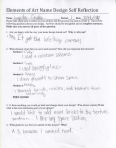HOPE Principle H1: Honor Student Diversity and Development
The HOPE principle H1 asks teachers to demonstrate a positive impact on student learning by honoring student diversity and development. In my recent experiences in the classroom, it has become very clear that I must dictate one general set of expectations to the whole class, and still be flexible, ready with alternatives for students with special needs, for those who missed content, or for instances when students simply need re-teaching. In a previous post, I cited Medina’s (2008) Brain rule #3: “Every Brain is wired differently” (p. 70). In my post I suggested that teachers can reach diverse classrooms of students:
While there is no way to provide a specifically suited learning experience for every student’s unique needs, teachers can use instructional strategies that will create more opportunities for each student to access a high-quality education. (Jones, 2013)
Last week students in the 6th grade art class turned in a project which was accompanied by a short personal written reflection. Students were given a printed worksheet with writing prompts which asked them to describe their experience and rationalize choices from their art project. There are two ELL students in the 1st period class, and I noticed that neither of them had completed the written reflection piece. I asked if they needed more time, or if the questions were difficult to read, but neither one would admit that it was hard to read, so I asked if it would be ok if I wrote their responses for them. They both responded positively, and I realized it was the writing that was their greatest challenge. The image shows how one student’s answers were written for them, making the reflection accessible.
Both students could comprehend the reading, but were slow and unable to write the words they wanted to use. I decided that I will provide more time for them in the future to complete writing assignments. Another adjustment I have made is to give all ELL students print-outs of the presentation slides I use when they are asked to copy down vocabulary definitions. Now these students have time and access to the language learning targets, and they get to practice writing academic art language in English.
I learned that I must reach out to students that I know have IEP, 504, or other needs such as language or vison deficits. My job is to give every student an equal opportunity to succeed and have access to the content I provide. I also recognize that students who miss even one lesson can also need extra support, and some personality types (shy students for example) are sometimes unable to articulate their learning needs, so I should try to take a moment to ensure they are getting the skills and content as well. In a classroom of 32 students, with a variety of social, emotional, psychological, and personal needs, all learning and achieving at the same level is simply not realistic. I must still plan and instruct to the group, but special attention to individuals can also be critical in ensuring I honor the diverse group of learners in every class.
Reference
Jones, S. (2013). Reflection | EDU6132 | HOPE Principle H1: My Interpretation. Susanna Jones bPortfolio (August 8, 2013). susannajonesbportfolio.wordpress.com.
Medina, J. (2008). Brain rules. Seattle, WA: Pear Press.

